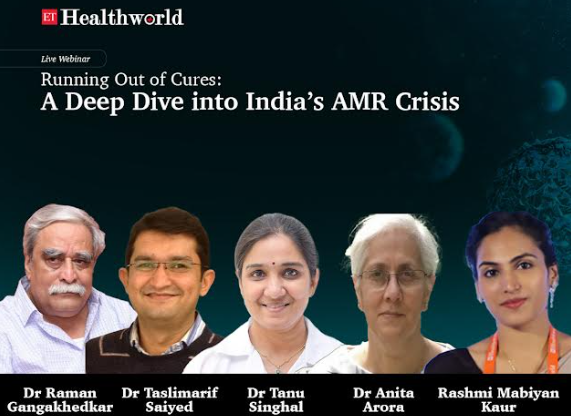
New Delhi: Antimicrobial resistance (AMR) is no longer a looming global health threat—it is already here, silently claiming thousands of lives across India every week. Infections that were once treatable are now proving deadly, and doctors are increasingly witnessing the failure of even last-resort antibiotics.
In a recent ETHealthworld webinar titled “Running Out of Cures: A Deep Dive into India’s Antimicrobial Resistance Crisis,” leading clinicians, researchers, and public health experts dissected the alarming rise of AMR and what India must do—urgently—to contain the fallout.
‘When Nothing Works’: A Clinician’s Dilemma
Dr. Tanu Singhal, Infectious Disease Specialist at Mumbai’s Kokilaben Dhirubhai Ambani Hospital, recalled devastating cases where no antibiotic proved effective. One such case involved a liver transplant patient battling multiple infections, including a highly drug-resistant Enterococcus faecium. “The infection was resistant to vancomycin, daptomycin, and linezolid. The only option was tigecycline—unsuitable for bacteremia. We eventually lost her. She left against medical advice, unable to afford prolonged care, and died en route to her home,” she said.
Even when effective drugs exist, the cost can be prohibitive. “We had to import cefiderocol rupees four lakh per day—for an patient with Acinetobacter pneumonia. Though we cured the infection, the patient eventually died of a heart attack due to prolonged hospitalization,” she added.
In neonatal care, the scenario is no better. “Gone are the days when ampicillin and gentamicin were enough. We now see newborns with carbapenem-resistant infections requiring colistin and even imported drugs like cefiderocol,” Dr. Singhal warned, citing India-specific studies showing alarmingly high resistance rates in neonatal sepsis.
Hospitals Prepared, But Surveillance Still Fragile
While larger hospitals are equipped to manage outbreaks, challenges persist, particularly in smaller and rural facilities. “Accredited hospitals have adequate manpower and isolation infrastructure for MDR cases,” said Dr. Anita Arora, Director of Medical Operations and IPC Head at Fortis Healthcare. “But gaps exist in standardization and surveillance, especially across the country’s vast non-accredited and tier-2, tier-3 healthcare facilities.”
Dr. Raman Gangakhedkar, former ICMR scientist and Distinguished Professor at Symbiosis International University, pointed out the lack of robust, generalizable AMR surveillance data as a major impediment to public health action. “ICMR’s surveillance network includes 20-odd urban tertiary hospitals. That doesn’t reflect the national AMR burden. Surveillance must extend to secondary and primary care levels—and even into communities—if we want real change,” he emphasised.
India’s National Action Plan on AMR, nearing a decade since launch, remains limited in its implementation. “We have a policy, but not a vertical program like for TB or HIV. That’s why AMR doesn’t get priority in funding or policy enforcement,” Dr. Gangakhedkar noted.
Despite sepsis from multi-drug resistant organisms becoming one of India’s top infectious killers, there is no emergency response system. “We lack a coordinated, multi-stakeholder approach. Without demand from the public or advocacy from clinicians, every death remains anecdotal,” he warned.
Dr. Taslimarif Saiyed, Director and CEO of C-CAMP, highlighted the emerging biotech response to AMR through the India AMR Innovation Hub (IAIH). “Over 80 new diagnostic and therapeutic innovations are in the pipeline, including point-of-care detection tools, small-molecule therapies, peptides, and even mAbs,” he said.
Within five years, IAIH aims to bring 15–20 AMR solutions to market. “Our focus is on affordability, accessibility, and adaptability to Indian healthcare settings. We are also partnering with state governments to test and deploy these solutions,” Dr. Saiyed said.
What Fuels the AMR Crisis?
Rampant over-the-counter (OTC) use and physician-driven overprescription are key drivers. “We frequently see patients self-medicating with azithromycin for fever,” said Dr. Singhal. “There’s an urgent need for public campaigns discouraging this behavior and educating people that antibiotics are not for viral infections.”
Physician behavior must also change. “Nearly 70% of outpatient visits are viral, yet antibiotics are often prescribed. Pharmacies dispensing antibiotics without prescriptions must be stopped. The government should crack down on irrational fixed-dose combinations and improve antibiotic quality,” she added.
India’s AMR crisis is tightly linked to its infectious disease burden. “If we reduce infections, we automatically reduce antibiotic use,” Dr. Singhal argued. “Better water, sanitation, hygiene, and vaccination—like typhoid vaccines—are critical long-term AMR containment tools.”
A Call for National Coordination and Accountability
All experts agreed that AMR cannot be tackled in silos. “This is not just a medical or regulatory issue. It’s a community issue, a veterinary issue, a poultry issue, a pharma issue. Everyone must be accountable,” Dr. Gangakhedkar stressed.
Dr. Arora echoed that sentiment: “No irrational antibiotic combinations should be manufactured or prescribed—anywhere. Regulatory agencies must crack down at the state level, and hospitals must not allow irrational drugs inside their doors.”
India’s AMR crisis is no longer silent—it is deafening for those willing to listen. But without systemic surveillance, public advocacy, rational prescription practices, and coordinated innovation, the country risks running out of curative options.
As Dr. Gangakhedkar summed it up: “Every patient asking, ‘Do I really need this antibiotic?’ is a step forward. Every death from untreatable infection must not be forgotten—it must become a rallying cry for urgent action.”